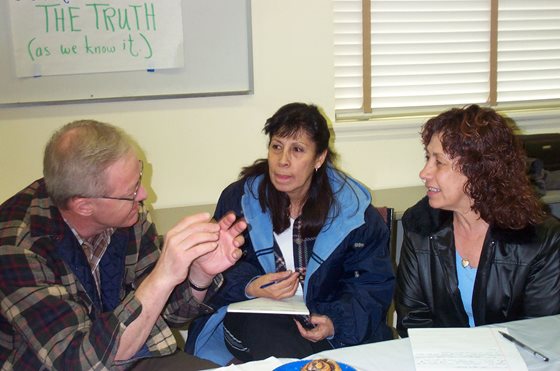More than a third of individuals and families in America live in rental housing—particularly those with lower incomes. In fact, almost 40 percent of renters qualify as “burdened”—spending a third or more of their pre-tax incomes on rent. That number grows to 46 percent among blacks and 50 percent among seniors. The result is a financial fragility that affects every aspects of their lives. In fact, a Pew Charitable Trust survey found that half of rent-burdened households had less than $10 in savings.
That’s why JPMorgan Chase recently supported NeighborWorks America in a pilot to explore how financial coaching and counseling can most effectively be provided to residents of multifamily rental developments. In 2017, NeighborWorks nonprofits owned 165,500 rental houses and apartments, called home by 295,000 individuals. It seemed a natural fit to examine how financial-education programming can be woven into the resident-support services already offered by these nonprofits—especially since, as property owners, they have a stake in assuring that tenants are able to pay their rents consistently and on time.
Half of rent-burdened households had less than $10 in savings.
Eighteen NeighborWorks network members were chosen for a pilot program to determine what services are most effective, why and how. “This was a valuable pilot because participants in traditional financial-capability programs tend to not be in crisis mode. Many who come in for help with homeownership typically have more income with which to work,” observes Brooke Linkow, NeighborWorks’ manager of financial capability in the Training Division. “But a lot of renters are living much closer to the edge, maybe on the edge of eviction or otherwise in crisis.”
“This was a valuable pilot because participants in traditional financial-capability programs tend to not be in crisis mode. Many who come in for help with homeownership typically have more income with which to work,” observes Brooke Linkow, NeighborWorks’ manager of financial capability in the Training Division. “But a lot of renters are living much closer to the edge, maybe on the edge of eviction or otherwise in crisis.”The results of the yearlong pilot are in and a central conclusion is that multifamily developments are particularly good venues for services designed to build financial resilience.
Participate in a webinar sponsored by the Center for Financial Security to hear NeighborWorks' Janet Raffel and representatives of two network member organizations discuss the findings and their experiences.
“This is where these residents live and staff typically have well-established relationships with residents, making it easier for them to develop the trust necessary to provide financial support,” explains Janet Raffel, senior manager of financial capability. “However, participants also learned that just being on site didn't help nearly as much as they expected. It’s still critical to do your homework and understand what issues residents struggle with. What financial goals do they care about, for example? Marketing, outreach and program delivery must be tailored to fit where people actually are to draw them in.”The results of the pilot reflected the benefits of this approach. Of the 411 renter participants who completed pre- and post-intervention evaluations:
- 29 percent of started a savings account.
- 49 percent increased the amount saved, making an average of 14 deposits over a six-month period.
- 49 percent improved their credit score by an average of 32 points.
Building trust is essential
 Due to the landlord-tenant relationship between property managers and residents, special attention is needed when the former refer the latter to financial coaches. Personal finance is a sensitive subject, especially when there is a power imbalance. Care must be taken to separate the role of the landlord from that of counselor and coach, with an emphasis on cultural sensitivity, patience and a nonjudgmental approach. One participant, CommonBond Communities in St. Paul, Minnesota, found it particularly helpful to staff the financial capability team with employees who already had existing, trusted relationships with residents, spoke multiple languages and had expertise across multiple social services.
Due to the landlord-tenant relationship between property managers and residents, special attention is needed when the former refer the latter to financial coaches. Personal finance is a sensitive subject, especially when there is a power imbalance. Care must be taken to separate the role of the landlord from that of counselor and coach, with an emphasis on cultural sensitivity, patience and a nonjudgmental approach. One participant, CommonBond Communities in St. Paul, Minnesota, found it particularly helpful to staff the financial capability team with employees who already had existing, trusted relationships with residents, spoke multiple languages and had expertise across multiple social services.One of the challenges the nonprofit encountered in its refugee community is the Muslim prohibition on charging or paying interest on loans, thus limiting the financial options. The language and cultural barriers also made it difficult for refugees and immigrants from countries like Somalia to understand the American financial system. However, patience and cultural sensitivity were successful; for example, one female Somali resident worked with a financial coach to develop a budget with a goal of buying a used car. After saving and careful planning, she was able to put half of the cost down initially and budgets for monthly payments. The vehicle allows her to go to work and take ESL classes.
Research, research, research
Rather than relying on perceived needs of residents, an effective program to build financial capability must be based on a foundation of in-depth research into their demographics, financial status (easily available through the annual income-certification process) and psychology. The latter can be assessed using focus groups, surveys and one-on-one conversations. Pilot groups used a common financial capability evaluation tool to learn about their residents at the start of the program, and then again at the end of services to see how attitudes and behaviors changed. (NeighborWorks’ Success Measures Financial Education and Capability Tools are designed to assess residents’ attitudes and behaviors.)Integrate enabling products and services
For example, five participating nonprofits that all use the same property-management company helped residents build improve their financial “reputations” by reporting on-time rent payments to a credit agency.Many low-income renters are among the 100 million U.S. consumers with no, thin or subprime credit. Historically, only homeowners have been able to build positive credit histories by making housing payments on time. However, now there is a way for renters to benefit from the same credit-building opportunity. In this pilot, NeighborWorks America engaged the Credit Builders Alliance (CBA) to guide the nonprofits’ property manager through the process of becoming a furnisher of rental data to credit calculator Experian RentBureau. To become a credentialed data furnisher, the company was required to submit an application to Experian and complete an assessment designed to test its rental data for integrity and accuracy.
 “Becoming a furnisher of resident rental payment data can take time for even the most committed property manager,” noted CBA in a report on its work with the participating groups. In addition, it can be a challenge to build up the trust required for residents to give permission for their rent histories to be shared. However, the benefits are significant. Residents with no existing credit score developed one, and 80 percent of those who already had scores increased them by an average of 28 points.
“Becoming a furnisher of resident rental payment data can take time for even the most committed property manager,” noted CBA in a report on its work with the participating groups. In addition, it can be a challenge to build up the trust required for residents to give permission for their rent histories to be shared. However, the benefits are significant. Residents with no existing credit score developed one, and 80 percent of those who already had scores increased them by an average of 28 points.
Many low-income renters are among the 100 million U.S. consumers with no, thin or subprime credit.
“The concept of credit and credit reporting can be difficult to explain,” notes Raffel. “Credit is your financial report card and it can save you as much as $250,000 over the course of your lifetime if you have a decent credit score—for example, by getting better loan terms and even helping you get a better job. But it requires a lot of education to get people to understand that.”The CBA report concludes, “Helping residents establish and improve their credit profiles is critical to their ability to participate in the financial mainstream, including obtaining loans for home purchases or other goals. Pairing a credit-building service, such as rent reporting, with credit education benefits all parties.” (Interested? Check out the CBA’s step-by-step implementation guidelines.)
Other services explored in the pilot were a prepaid debit card for those with no bank account (thus allowing them to access lower-cost financial services) and a matched-savings program. Participants in the latter discovered they could save on a regular basis. A total of 254 participants made an average of 13-14 deposits and saved more than $300,000 over the six-month period.
Differentiate between crisis and goal planning
Hopefully, says Raffel, “the first encounter with the financial capability team isn’t when somebody can't pay their rent and eviction is imminent. Integrated client-management systems can flag early warning signs and help get residents back on track.” However, sometimes that’s where residents are, and then the need is for counseling and intervention—not coaching.This is where eviction prevention services play critical roles. For example, Champlain Housing Trust (CHT)in Vermont had been operating a sophisticated eviction prevention program called On Track, to help residents who miss a rent payment. Such programsrequire cross-training between property-management and financial-capability staffs. It can be a significant culture change for the former.
CHT recognized that many residents get so far behind in their rent and other expenses, they can’t catch up without a long term repayment option. . The organization adapted its revolving loan fund for home repairs to create a 12- 18-month loan product for people on the brink of eviction. If residents can't repay their rent arrearage within six months, it’s converted into a loan reported to the Credit Bureau that then builds up their credit score.
“Eviction prevention also makes sense from a strict property interest as well,” notes Raffel. “Our organizations have been tracking savings in costs like legal fees, turnover and lost rent, and they are finding that eviction-prevention activities more than pay for themselves. We’re seeing lots of creativity going on to help people stay in their homes.”
.

